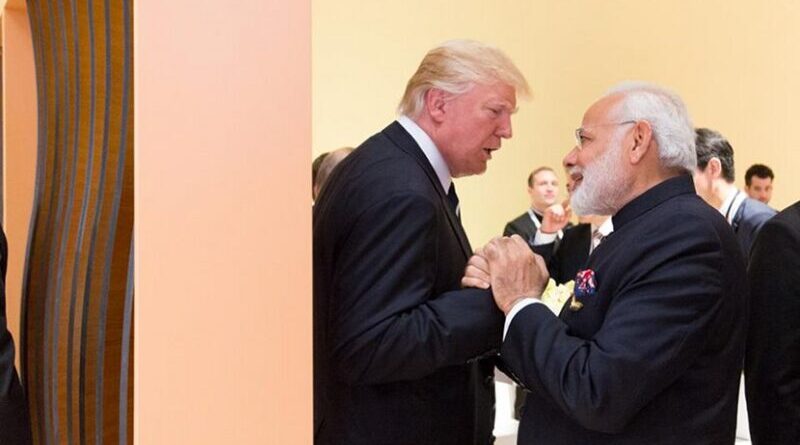Trump’s Tariff Hikes: China To Lose More In Retaliation, India Insulated – OpEd
Fears of trade war loomed large after Trump administration decided to impose high tariffs on steel, aluminum , solar panels and washing machines. The immediate impact was transmitted in BSE Sensex which dipped sharply by over 1,000 points within two days of working in the second week of March.
On January 23, 2018, Trump announced that it would impose tariffs on imported solar panels by 30 percent and 20 percent on washing machines. On March 1, the USA imposed 25 percent tariff on imported steel and 10 percent tariff on aluminum. The target was China , which let USA dipped into wide trade deficit. In 2017, China accounts for 47 percent US global trade deficit.
To retaliate the moves, China opened the investigations for Anti- Dumping and Anti Subsidy into sorghum imported from USA. China accounts for 79 percent of US exports of sorghum. MOFCOM ( Ministry of Commerce, People’s republic of China) said that there was ample evidences to believe that the dumping and subsidies were causing harm to Chinese domestic producers of sorghum.
Arguments are leveled against the Chinese equivalent power to retaliate against Trump’s protectionism. According to Mr Gary Hufbaucer, Senior Fellow at Peterson Institute for International Economics in Washington, China is to loose more than USA , because China is more dependent on exports to USA than vice-versa and USA is in a better position to find alternative market than in China.
According to World Bank, China’s trade accounted for 37 percent of its GDP , compared to 26.5 percent for the trade ratio of USA. The heavy reliance on trade suggests that China will face more damages if it adopts sever retaliatory measures against Trump’s tariff hikes.
Even though Trumps adopts for protectionism, targeting China as it owes large trade surplus with USA, India is insulated from Trump’s venom for protectionism. This is because India’s share in trade deficit with USA is at much lower ebb than China. India accounts for 3 percent of USA’s world trade deficit, compared to 47 percent by China.
USA accounts for only 4 percent of India’s steel exports. Steel exports accounts for only 10 percent of India’s steel production. Therefore, impact of high tariffs on steel by USA is negated by the insignificant exports by India. As a matter of fact, high tariffs in USA will find new markets for India to diversify its steel exports and increase domestic sales with the upsurge in infrastructure projects.
Similarly, the USA accounts for 6-7 percent only of India’s exports of aluminum. Tariff impose will unlikely impart any major impact on India’s of aluminum.
India is screwed by the USA for its over-supply of IT services, causing damage to the American jobs. This led USA to invoke stricter HI B visa for movement of human resources. Tariff hikes and non-tariff barriers should not pose a damage to India’s trade relation by Trump’s protectionism. India’s major export items to USA are diamonds, pharmaceutical products, textiles and oil refinery products.
As a matter of fact, Indian Prime Minister Narendra Modi upped the ante for protectionism at home and advocated globalization for world growth in the world forum.
In December 2017, import duties were raised on various electronic items, including mobile phones, microwave ovens , cameras and others. The move was viewed as a step to bolster employment through incentivizing domestic industries. It did not end here. The move was further accelerated by imposing high tariff barriers on auto components, CKD and CBU motor vehicles, bus and truck tire and perfumes and toiletries in the budget for 2018-19. These hikes in custom duties were mainly to protect the domestic industries.
India reverted to import substitution program to inject a new lease of life in the Make in India initiative. In 2016, Ministry of Urban Development made it mandatory to procure railway equipment for metro projects from domestic sources. According to the policy, a minimum of 75 percent of metro coaches and critical signaling equipment are to be procured from domestic sources by the Central and State level metro project authorities.
Trade relations between India-USA and Sino-India are diagonally opposite to each other. While India has trade surplus with the USA, it has trade deficit with China, with greater magnitude. While India woos American investors for advancement of technology and innovation, India urges China to invest to counterbalance the trade deficit. In the Joint Statement, both Trump and Modi pledged for deepening defense cooperation, recognizing India as a “Major Defense Partner”. The emphasis was for working together for advanced defense equipment and technology. This refers to a significant take way by Modi to woo the USA investors in defense, which was greatly opened for the foreign investors during his regime.
The importance of US President Donald Trump is his inconsistency. He is unpredictable and naïve in diplomacy. Even though his isolationist policy “ American First “ was the driving force to win the unexpected battle of election, his warm greetings and roll out of red carpet to Modi, treating him a Good friend, will further advance Indo-US relations, which was built during the three years period of Obama regime.
Therefore, it is unlikely that India will toe with China to raise concern over the Trump’s protectionism, which China will muster the support of its allies by provoking that protectionism will jeopardize global growth.
Views are personal

